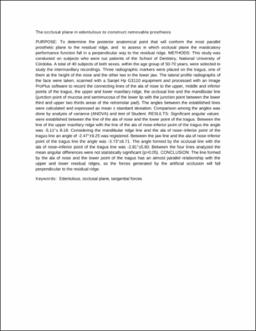| dc.contributor.author | Vera, Mónica | |
| dc.contributor.author | Pescio, Jorge | |
| dc.contributor.author | Ponce, Rubén | |
| dc.date.accessioned | 2019-10-29T16:05:45Z | |
| dc.date.available | 2019-10-29T16:05:45Z | |
| dc.date.issued | 2013 | |
| dc.identifier.issn | ISSN: 0022-0345 | |
| dc.identifier.uri | http://hdl.handle.net/11086/13467 | |
| dc.description.abstract | To determine the posterior anatomical point that will conform the most parallel prosthetic plane to the residual ridge, and to assess in which occlusal plane the masticatory performance function fall in a perpendicular way to the residual ridge. METHODS: This study was conducted on subjects who were out patients of the School of Dentistry, National University of Córdoba. A total of 40 subjects of both sexes, within the age group of 50-70 years, were selected to study the intermaxillary recordings. Three radiographic markers were placed on the tragus, one of them at the height of the nose and the other two in the lower jaw. The lateral profile radiographs of the face were taken, scanned with a Sanjet Hp G3110 equipment and processed with an Image ProPlus software to record the connecting lines of the ala of nose to the upper, middle and inferior points of the tragus, the upper and lower maxillary ridge, the occlusal line and the mandibular line (junction point of mucosa and semimucosa of the lower lip with the junction point between the lower third and upper two thirds areas of the retromolar pad). The angles between the established lines were calculated and expressed as mean ± standard deviation. Comparison among the angles was done by analysis of variance (ANOVA) and test of Student. RESULTS: Significant angular values were established between the line of the ala of nose and the lower point of the tragus. Between the line of the upper maxillary ridge with the line of the ala of nose-inferior point of the tragus the angle was -5.11°± 8.18. Considering the mandibular ridge line and the ala of nose?inferior point of the tragus line an angle of -2.47°±9.25 was registered. Between the jaw line and the ala of nose-inferior point of the tragus line the angle was -3.73°±6.71. The angle formed by the occlusal line with the ala of nose?inferior point of the tragus line was -2.81°±5.60. Between the four lines analyzed the mean angular differences were not statistically significant (p>0.05). CONCLUSION: The line formed by the ala of nose and the lower point of the tragus has an almost parallel relationship with the upper and lower residual ridges, so the forces generated by the artificial occlusion will fall perpendicular to the residual ridge. | en |
| dc.format.medium | Digital | |
| dc.language.iso | eng | en |
| dc.rights | Attribution-NonCommercial-ShareAlike 4.0 International | * |
| dc.rights.uri | http://creativecommons.org/licenses/by-nc-sa/4.0/ | * |
| dc.subject | Edentulous | en |
| dc.subject | Occlusal | |
| dc.subject | Plane | |
| dc.subject | Tangential | |
| dc.subject | Forces | |
| dc.title | The occlusal plane in edentulous to construct removable prosthesis | en |
| dc.type | article | en |
| dc.description.version | publishedVersion | |
| dc.description.fil | Fil: Vera, Mónica. Universidad Nacional de Córdoba. Facultad de Odontología; Argentina. | es |
| dc.description.fil | Fil: Pescio, Jorge. Universidad Nacional de Córdoba. Facultad de Odontología; Argentina. | es |
| dc.description.fil | Fil: Ponce, Rubén. Universidad Nacional de Córdoba. Facultad de Odontología; Argentina. | |
| dc.journal.city | Minnesota | |
| dc.journal.country | Estados Unidos | |
| dc.journal.editorial | SAGE | |
| dc.journal.pagination | 10-11 | |
| dc.journal.referato | Con referato | |
| dc.journal.title | Journal of Dental Research | en |





